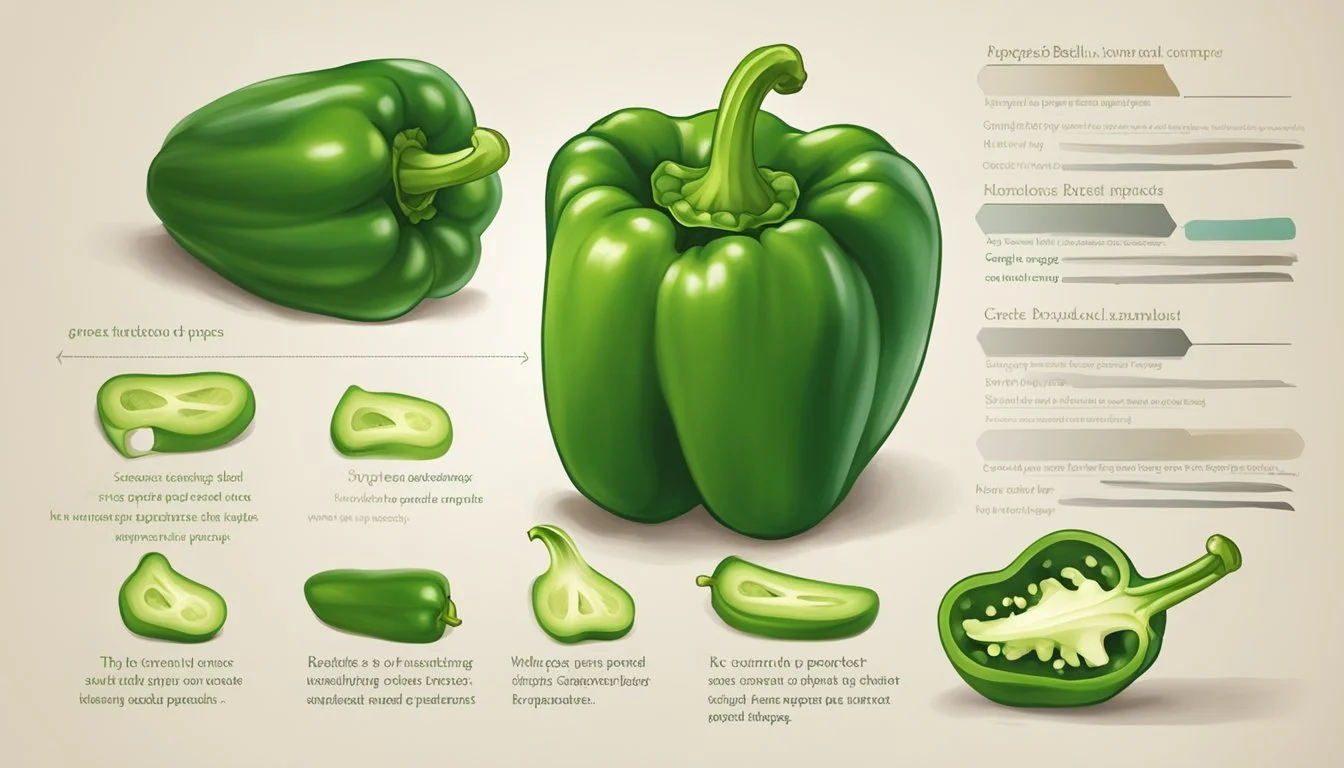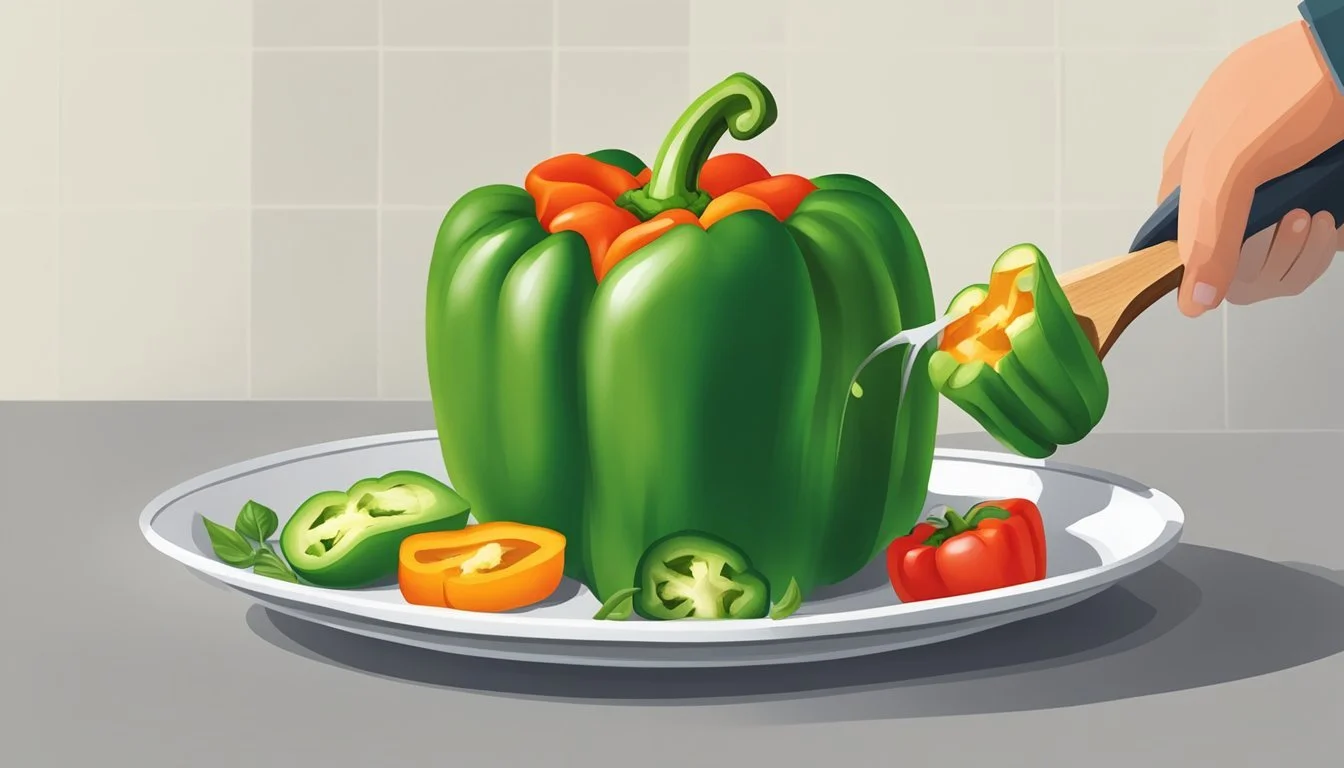How to Substitute Green Bell Pepper for Red Bell Pepper
Flavor and Recipe Adjustments
Green bell peppers are a staple ingredient in many cuisines, known for their crisp texture and mildly sweet flavor. However, there are situations where a recipe calls for red bell peppers (What wine goes well with bell peppers?), which can be sweeter and more vibrant in color. Whether due to personal preference, dietary restrictions, or availability, cooks may need to find suitable substitutes for red bell peppers.
In these instances, understanding how to best swap in green bell peppers or other alternatives is vital for the success of a dish. Green bell peppers can provide a similar texture to red bell peppers, though the flavor profile is slightly less sweet. If the sweetness is a critical aspect of the dish, incorporating a pinch of sugar or another naturally sweet ingredient might bridge the gap.
Other substitutes for red bell peppers can also include vegetables such as carrots or tomatoes for sweetness, or poblano peppers for a slight kick, alongside the green bell peppers to maintain the texture. Knowing how to balance these substitutes in terms of flavor, color, and texture is crucial for anyone looking to adapt their recipes without compromising the overall taste and appearance of the final product.
Understanding Bell Peppers
Bell peppers are a versatile and colorful vegetable, offering not only visual appeal to dishes but also varied flavors and textures. They are commonly found in four colors—green, red, yellow, and orange—each with its unique taste and nutritional profile.
Varieties and Characteristics
Bell peppers are members of the Capsicum annum species and come in a range of colors, which actually represent different stages of ripeness. Green bell peppers are the least ripe, harvested before they change color. They have a slightly more bitter taste and are firmer in texture, providing a desirable crunch when eaten raw or cooked. As they mature, they may transition to yellow and orange, with an increasing level of sweetness. Red bell peppers are the most ripe, boasting the sweetest flavor and the richest in vitamin content among the spectrum.
Textures of Bell Peppers by Color:
Green: Crisp and slightly bitter
Yellow/Orange: Softer texture with a balanced sweetness
Red: Juiciest and sweetest among the varieties
Nutritional Value
Bell peppers are not only a colorful vegetable to add to one's diet but also a nutritious one. They are an excellent source of vitamin C, surpassing even oranges in the amount per serving, which is crucial for immune system function. Additionally, they offer fiber and potassium, contributing to digestive health and maintaining healthy blood pressure levels respectively.
Nutritional Contents in Bell Peppers:
Vitamin C: Essential for immune health and antioxidant properties
Fiber: Aids in digestion and promotes satiety
Potassium: Helps regulate fluid balance and blood pressure
Regardless of their color, bell peppers are low in calories, making them a healthy choice for those looking to add more vegetables to their meals.
Culinary Uses of Bell Peppers
Bell peppers, with their vibrant colors and versatile flavor profiles, are a cornerstone in both raw and cooked dishes. They range from the crisp, slightly bitter green variety to the sweeter red, orange, and yellow peppers, adapting to various culinary applications.
Bell Peppers in Raw Dishes
In raw preparations, bell peppers add a crunchy texture and a pop of color to dishes. Green bell peppers are a staple in salads, often diced or julienned to complement leafy greens and other salad ingredients. They deliver a more vegetal, less sweet flavor compared to red bell peppers, which are commonly found in Italian-style antipasti, showcasing their more pronounced sweetness.
Recipes ideal for raw bell peppers:
Garden salads
Antipasto plates
Salsa and dips
Red bell peppers are also frequently used to add a bright splash to fresh salsas (how long do fresh salsas last?) or as a colorful garnish on pizzas and sandwiches.
Cooking with Bell Peppers
When cooked, bell peppers become tender and their flavor profile changes subtly. Green bell peppers hold up well to heat and are a favorite in stir-fries, where they retain some of their crispness. Their mild bitterness is a good balance to the savory and sweet flavors of the dish.
Cooked dishes with bell peppers:
Stir-fries: Heat-efficient cooking that highlights bell pepper's texture.
Pizzas: Sliced or diced for a vibrant topping.
Stuffing: Green peppers are often hollowed and filled with a mixture of meats, rice, and spices.
Casseroles: A hearty addition offering sweetness and color contrast.
Soups: Red peppers, when roasted, enrich soups with a deep, smoky sweetness.
Fajitas: Typically sautéed with onions and served with protein.
Roasted red bell peppers are particularly valued for their soft texture and sweet, deep flavor, making them an excellent choice for recipes needing a richer taste without the sharp bite of the green variety.
Substituting Bell Peppers
When substituting bell peppers in recipes, it's essential to consider the flavor profile, texture, and color impact on the dish. The goal is to maintain balance while achieving a similar culinary contribution.
Considerations for Substitution
One must consider the sweetness, heat, and texture when replacing green bell peppers with red ones. Green bell peppers are less ripe and have a slightly more bitter and earthy flavor compared to the sweeter, fully ripe red bell peppers. The texture of red bell peppers is also softer after cooking, which could affect the final dish.
Alternative Pepper Substitutes
For dishes requiring a similar sweetness to red bell peppers, poblano, Anaheim, and cubanelle peppers can be appropriate substitutes. While these alternatives can offer a similar texture and color, there is a mild increase in heat:
Poblano peppers: Rich flavor, mildly spicy.
Anaheim peppers: Slightly sweet, minimal heat.
Cubanelle peppers: Sweet with thin flesh, slight heat.
For a sweeter flavor profile without the heat, pimento or banana peppers may serve as suitable replacements. Jalapeños can be used for those who prefer a spicier kick.
Non-pepper Vegetable Substitutes
Should the recipe allow, several non-pepper vegetables can stand in for red bell peppers:
Zucchini: Milder taste, absorbs surrounding flavors.
Onions: Add sweetness and a distinct flavor when cooked.
Celery: Provides a crunchy texture and a neutral taste.
Tomato: Introduces acidity and moisture with a red color, albeit with a softer texture.
Keep in mind that each substitute will alter the original taste and texture of the dish, and should be chosen based on their compatibility with other ingredients and the desired outcome of the recipe.
Recipes Featuring Bell Pepper Substitutions
In the culinary realm, bell peppers offer a vibrant burst of color and a subtle sweetness to dishes. When substituting green bell peppers for red, one should consider the slight taste and textural differences, especially in recipes that leverage red bell peppers for their distinct flavor and aesthetic contribution.
Raw Preparations
Green bell peppers can be a suitable substitute for red bell peppers in raw dishes to retain that crunchy texture. They are less sweet than red bell peppers but provide a similar crispness to salads and garnishes.
Salads: Simply chop or slice green bell peppers and add them to salads where red bell peppers are called for. They maintain a fresh, crunchy texture and will contribute a slightly more vegetal flavor to the dish.
Hummus: When garnishing hummus, diced green bell peppers can offer a contrasting color and a crunchy texture. The mild bitterness may be distinct from the sweetness of red bell peppers but still works well with the creamy chickpea dip.
Cooked Creations
While green bell peppers can sometimes assert a stronger flavor once cooked, they often make a good stand-in for red bell peppers in heated recipes. The key is to match the cooking times and methods to achieve a similar consistency.
Stir-Fry: For stir-fries, green bell peppers work well as they soften similarly to red bell peppers. Begin by cutting them into identical-size pieces to ensure even cooking.
Stuffed Bell Peppers: When stuffing bell peppers, use green instead of red, and consider adjusting the seasoning to balance the slightly sharper taste of green bell peppers with the other filling ingredients.
Preserved: When preserving bell peppers in oils or pickling in jars, green bell peppers may not offer the same sweetness as red, yet they will provide a pleasant, tangy alternative that complements a variety of preserved vegetables.
Final Tips and Tricks
When substituting green bell peppers for red, one must consider the alterations in spice balance and flavor profiles. Proper preservation and storage techniques also play a critical role in maintaining the pepper's quality.
Adjusting Spice Levels
Green bell peppers have a grassier and more bitter flavor than the sweeter red bell peppers. For dishes that benefit from a hint of spice, one may add mild to medium heat chilies like poblano or Anaheim peppers. Alternatively, for a spicier kick, a pinch of cayenne pepper or finely chopped Sichuan peppers can elevate the heat. Below is a guide to adjusting spice:
Mild: Add a dash of paprika for a mild, slightly sweeter heat.
Medium: Incorporate diced poblano or a small amount of pepperoncini.
Spicy: Sprinkle cayenne or include minced Sichuan peppers sparingly for intense heat.
Enhancing Flavor Combinations
To complement green bell peppers' bitterness and enhance the overall flavor, one can add sweet peppers for balance. The introduction of aromatic spices like garlic and shallots can also enrich the flavor profile. Here's a quick list of flavor enhancers:
Spices: garlic, shallots, or paprika
Sweetness: add sweet peppers like red capsicum for balance
Depth: incorporate roasted garlic or caramelized onions for complexity
Preservation and Storage
Ensuring the longevity of green bell peppers is vital. If fresh, they should be stored in the refrigerator's crisper drawer. For long-term preservation, they can be pickled or stored in jars with proper canning procedures. See the storage recommendations:
State Storage Technique Location Fresh Refrigerator crisper Cool, dry place Pickled Sealed in jars Refrigerator Preserved Proper canning Pantry or fridge
Potential Health Considerations
When substituting green bell peppers for red bell peppers, individuals should be aware of several health considerations. Although bell peppers are generally seen as healthy, individual reactions and ripeness can affect both health outcomes and cooking results.
Ripeness: Red bell peppers are fully ripened green bell peppers. As they ripen, they typically become sweeter and may be easier to digest for some people compared to the somewhat more bitter and fibrous green bell peppers.
Digestive Sensitivity: Individuals with sensitive stomachs may experience indigestion when consuming green bell peppers. This can be due to the tougher skin and higher levels of certain compounds found in unripe peppers.
Allergic Reactions: Bell pepper allergies are rare but possible. Those with known allergic reactions should be cautious and consult a healthcare provider before making any substitutions.
Nutrient Profile: It's important to note that red bell peppers contain higher amounts of certain vitamins, such as Vitamin C and beta-carotene, compared to their green counterparts. Consumers may need to adjust their diet accordingly to meet their nutritional needs.
Nutritional comparison in brief:
Nutrient Green Bell Pepper Red Bell Pepper Vitamin C Lower Higher Beta-carotene Lower Higher
Substituting green peppers where red peppers are indicated assumes that one is aware of these considerations and makes an informed choice based on personal health circumstances.






